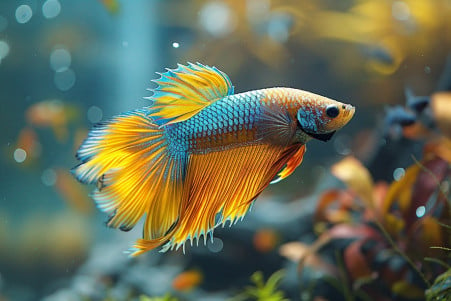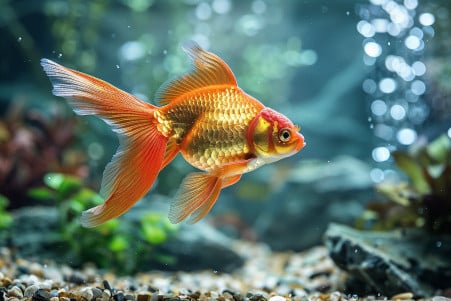Do Goldfish Need a Heater? Optimal Tank Temperatures for Healthy Fish
19 March 2024 • Updated 18 March 2024

When it comes to keeping your goldfish healthy, you need to think about more than just the cleanliness of their water—what about the temperature? Goldfish are healthiest when the water they live in is between 65–74°F.
Most of the time, you won’t need a heater unless you have fancy goldfish, who prefer their water to be between 72–78°F. However, you will need to keep an eye on the water temperature with an aquarium thermometer, especially if the room your goldfish are in is cooler or warmer than the ideal temperature range.
This article references a wide variety of scientific research and expert care guides from ichthyologists and aquarium specialists. These professionals have gone in-depth to study goldfish’s physiological reactions to different temperatures, the impact of water temperature on their overall wellness and behavior, and have provided valuable information on how to maintain the best tank conditions.
This article will give you a comprehensive view of whether or not you need a heater in your goldfish tank and how to make sure you’re setting up the best conditions for your fish to live a long and healthy life.
Do goldfish need a heater?
Goldfish and the Goldilocks Zone: Adapting to Temperature Extremes
Goldfish have shown an impressive ability to adapt to a wide range of temperatures, with a study in ScienceDirect reporting that their critical thermal minima and maxima can be as low as 0.3°C and as high as 43.6°C.
While this demonstrates the goldfish’s adaptability, it also shows that they are most comfortable within the moderate range mentioned above.
At the same time, another study on PubMed explains how goldfish change their intestinal functions in response to sudden temperature changes, going through a three-phase adaptation process. This includes short-term changes in membrane permeability and long-term changes in sodium-pump activity, which shows that goldfish have complex physiological reactions to changes in their environment.
In addition, a study in the Journal of Comparative Physiology A shows that there is a relationship between goldfish behavior and temperature, proving that changes in synaptic membrane fluidity and fatty acid composition during temperature acclimation influence the goldfish’s behavioral tolerance to heat.
These evolutionary changes, which balance membrane viscosity with the changes in the environment’s temperature, help the goldfish not just survive but thrive in a variety of temperature zones. This also helps explain the care that goldfish need to stay healthy, especially in terms of the water they live in.
Finding the Right Temperature: What Temperature Do Goldfish Like?
Water temperature has a direct impact on goldfish health, affecting their metabolism and immune function. The Goldfish Tank explains that the best temperature for most goldfish types is between 68°F to 74°F. This temperature range will allow goldfish to grow well while avoiding the stress of high temperatures and low oxygen levels.
That said, if you want to breed goldfish, it’s important to create temperature changes. You can do this by lowering the temperature to around 54°F in the winter and then raising it back to the normal range to mimic the changing seasons, which can help induce breeding, according to Luke’s Goldies.
Different types of goldfish have different temperature needs. Common goldfish, which includes comets and shubunkins, are hardy and can handle a wider range of temperatures, while fancy goldfish like orandas and ranchus do better in slightly warmer temperatures, between 72°F to 78°F, because they can develop health problems in colder water.
It’s important to keep the temperature stable. It’s best to check the temperature regularly with a reliable aquarium thermometer and keep the tank away from heat sources and direct sunlight to prevent temperature fluctuations, says Chewy Editorial. By keeping the temperature stable, we can make sure our goldfish are comfortable and healthy and can thrive.
Solving the Temperature Puzzle: Goldfish Well-Being and Temperature
Water temperature is critical for goldfish well-being as it impacts their metabolism and feeding patterns. An article on PMC notes that the metabolic rate of goldfish increases with water temperature, leading to higher oxygen demand and changes in feeding patterns.
A study on ScienceDirect explains that goldfish thrive best in a specific temperature range for growth and reproductive success, and moving outside of that range can lead to health problems.
Water temperature also affects goldfish cognition and swimming. An article published on PMC explains that changes in water temperature can change the sensitivity of sensory systems, which can impact a goldfish’s ability to forage for food. Meanwhile, water temperature also impacts goldfish reproductive cycles; a report by Aquasend notes that most fish need a specific temperature range to reproduce successfully.
In terms of behavior, goldfish show different levels of activity in different water temperatures. Colder water leads to less activity, while warmer water leads to more activity. Monitoring and maintaining the right water temperature can help improve goldfish well-being, prevent health problems, and ensure that goldfish are able to exhibit their natural behaviors.
Keeping the Balance: Water Quality and Goldfish Wellness
Water quality, which is the foundation of a goldfish’s environment, relies on stable temperatures to keep it in balance. The Goldfish Tank explains that temperature changes can cause ammonia and pH levels to fluctuate wildly, and these two factors are the balance that, when thrown off, can weaken a goldfish’s immune system.
By keeping the temperature stable, you can make sure that toxic compounds like ammonia stay at safe levels, which in turn will prevent stress and the resulting health problems in your goldfish.
The Spruce Pets points out that this balance is very sensitive and that owners need to keep a close eye on the pH and ammonia levels in the tank. Even small changes in temperature can disrupt the nitrogen cycle, causing these levels to rise and put your goldfish at risk.
A study in PMC also found that the substrate in your tank can affect the quality of the water, and that gravel and sand can raise the pH and create harmful bacteria if they aren’t managed properly.
Goldfish owners can make sure that the water quality in their tanks stays at optimal levels by using heaters to keep the temperature stable, testing the water for the right levels of different factors on a regular basis, and making sure that the tank’s substrate is cleaned regularly and thoroughly. Not only will this help your goldfish stay healthy, but it will also make sure that the ecosystem in your home aquarium thrives.
How to Choose and Maintain Heaters for Goldfish
To keep your goldfish in the most comfortable environment, it’s important to choose the right heater for your tank. The Spruce Pets explains that there are a few different types of heaters, including hang-on-tank, submersible, and heating cables. Submersible heaters are the most popular for goldfish tanks because they are the most effective at keeping the water at a consistent temperature.
When choosing a heater, you’ll need to consider the size of your tank and the average temperature of the room. The Spruce Pets says that the general guideline is to use 2.5 to 5 watts per gallon of water. This will make sure that the heat is distributed evenly, especially in larger tanks where you may need more than one heater to keep the temperature consistent.
To make sure that your heater is safe, use suction cups to secure submersible heaters to the tank, and make sure that they are not touching the gravel. To make sure that you and your fish are safe, always unplug the heater before you do any tank maintenance.
First Tank Guide also explains that it’s important to make sure that your fish can’t get too close to the heater, as they can get burned. Make sure that the heater always has water between it and any other surface.
You can make sure that your heater is working properly by checking it regularly, using a separate thermometer to check the water temperature, and watching your fish for any signs of distress. A well-maintained heater will not only keep your fish warm, but it will also give you peace of mind that your fish are comfortable and healthy.
Thinking About Temperature and Goldfish
In summary, our voyage through the aquatic world has shown that goldfish, despite their amazing adaptability, have temperature requirements that change based on their breed and stage of life. This is especially true for fancy goldfish, which need a higher temperature range to thrive. Heaters can help ensure that these fish are able to maintain the temperatures that are best for their overall health, which can help prevent changes in behavior and stress-induced diseases.
It is up to goldfish owners to make sure that the temperature is right. This will help ensure that the environment is as healthy as possible, which will in turn help goldfish live longer and happier lives.
This also means that it is up to goldfish owners to make sure that the tank is managed properly. This includes making sure that the right heating equipment is used, that the water is checked regularly, and that the fish are observed for signs of stress and other issues.
In the end, make sure that you are always learning more about the specific needs of your goldfish and that you are keeping up with the latest research. By doing this, you will be able to make sure that you are providing your goldfish with an environment that is as close to their natural habitat as possible.
And always remember that a well-managed tank is the best way to ensure that your goldfish are healthy, happy, and coexisting peacefully.


